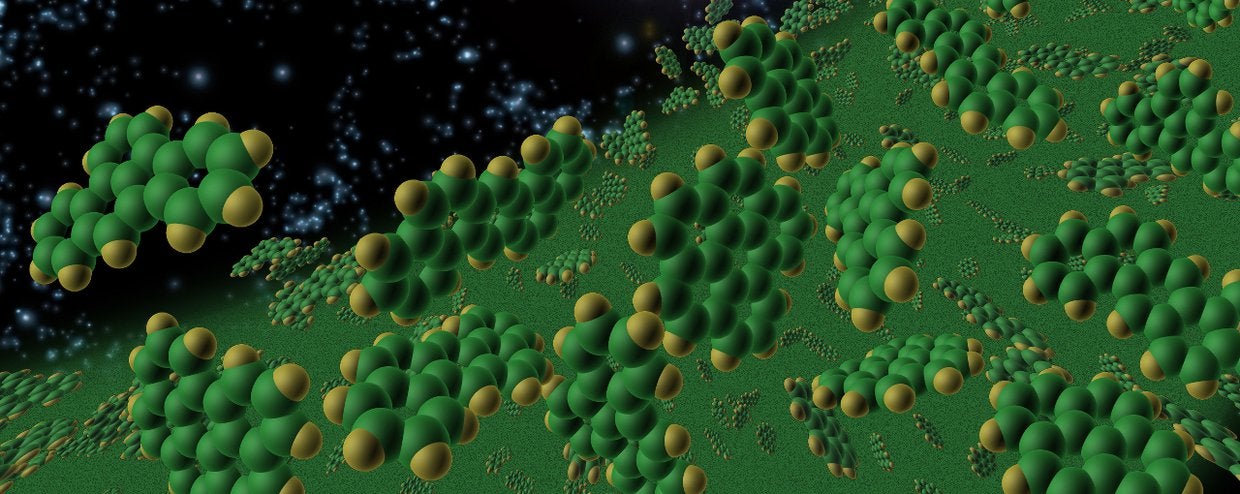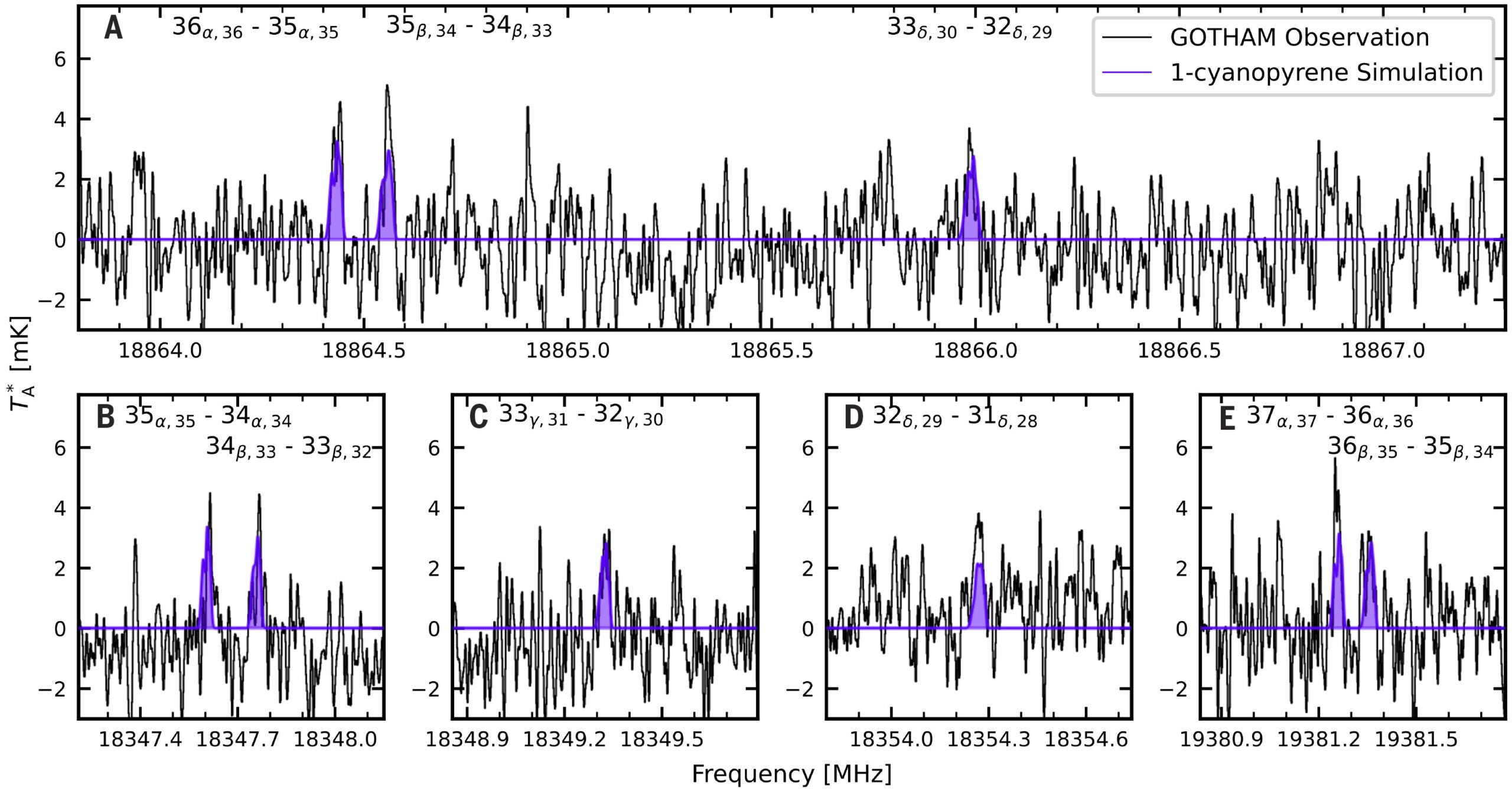Polycyclic aromatic hydrocarbons (PAHs) are an abundant class of organic molecules in space, playing a significant role in the interstellar medium (ISM). These molecules, composed of fused carbon rings, are thought to store 10 to 25 percent of all carbon in space.
Researchers have recently made a groundbreaking discovery of pyrene, a four-ring PAH, in the interstellar gas cloud TMC-1, a finding that deepens our understanding of the chemical inheritance of our solar system.
PAHs have been detected in various astronomical environments, including meteorites, comets, and asteroid samples. Infrared spectroscopy initially hinted at their presence decades ago, but it could not identify specific PAHs.
Recent advancements in radio astronomy, published in the journal, Science, have overcome this limitation by identifying molecules based on their rotational spectra. Using this technique, scientists have pinpointed individual PAHs such as cyanonaphthalene and now cyanopyrene, a modified version of pyrene with a cyanide group.

TMC-1, a cold interstellar cloud with a temperature of only 10 kelvins, provided the setting for this discovery. The team, led by researchers at MIT, used the Green Bank Telescope in West Virginia to detect cyanopyrene. This detection not only marks the largest molecule found through radio astronomy but also underscores the molecule’s stability in the harsh interstellar environment.
The significance of PAHs in space extends far beyond their chemical structure. These molecules act as reservoirs of carbon, influencing the formation of more complex organic compounds.
The fact that PAHs have been found in meteorites and asteroid samples suggests a direct connection between interstellar chemistry and the chemical inventory of planets, including Earth. Understanding how these molecules form and survive in space provides crucial insights into the origins of life’s building blocks.
Pyrene’s unique properties make it a focal point for researchers. Its symmetry usually renders it invisible to radio astronomy, but the addition of a cyanide group enabled its detection. Once formed, pyrene’s structure is highly resistant to destruction.
Related Stories
The researchers estimated that cyanopyrene accounts for 0.1 percent of the carbon in TMC-1, a surprisingly high figure given the diversity of carbon-containing molecules in space. As Brett McGuire, assistant professor of chemistry at MIT, notes, this finding highlights pyrene as an “interstellar island of stability.”
The importance of this discovery extends beyond the interstellar cloud. Samples returned from the asteroid Ryugu during the Hayabusa2 mission revealed significant amounts of pyrene, suggesting a shared chemical heritage with TMC-1.
These findings collectively strengthen the hypothesis that PAHs, including pyrene, contribute significantly to the carbon inventory that eventually forms solar systems.
Pyrene’s abundance in these environments highlights its resilience under extreme conditions. Unlike smaller PAHs, which are often destroyed by ultraviolet radiation and cosmic rays, larger PAHs like pyrene exhibit remarkable stability.

This resilience makes them crucial carriers of carbon through the various stages of star and planet formation. Pyrene’s detection in TMC-1 thus provides a valuable link between interstellar chemistry and the processes that shape planetary systems.
The origins of PAHs in space remain a topic of debate. High-temperature environments, such as those around dying stars, could facilitate their formation, but low-temperature conditions like those in TMC-1 may also play a role. In laboratory settings, scientists have successfully synthesized cyanopyrene, confirming its possible formation at low temperatures. This dual pathway to PAH creation emphasizes their resilience and adaptability across varied cosmic environments.
While small PAHs are typically destroyed by ultraviolet radiation and cosmic rays, larger PAHs like pyrene demonstrate remarkable stability. Laboratory isotopic analyses indicate that some PAHs in meteorites originated in cold interstellar conditions, aligning with findings from TMC-1. However, the exact mechanisms driving their formation and survival remain an active area of research.
Theoretical models suggest that PAHs form through mass growth processes influenced by the environment’s temperature and radiation. In colder regions, like TMC-1, these processes might be slow but result in highly stable molecules.

Conversely, high-energy regions around stars may produce PAHs more rapidly. Studying these contrasting pathways could reveal the conditions under which PAHs transition from interstellar clouds to the ISM and eventually to planetary systems.
Interstellar clouds like TMC-1 serve as precursors to stars and planetary systems. The discovery of pyrene in such environments provides a crucial link between the early chemical inventory of molecular clouds and the building blocks of planets.
As McGuire states, this discovery offers “the strongest evidence ever of this direct molecular inheritance from the cold cloud all the way through to the actual rocks in the solar system.”
This finding also has implications for understanding how carbon—a key element for life—is distributed and preserved in space. The stability and abundance of pyrene suggest it could play a foundational role in the chemical evolution of solar systems. Further studies aim to explore even larger PAHs and determine whether molecules like pyrene form within interstellar clouds or originate from elsewhere in the universe.

Additionally, the presence of pyrene in both TMC-1 and asteroid samples points to a shared chemical heritage across the cosmos. By tracing the journey of these molecules, scientists can better understand the processes that influence the composition of planets and the potential for life. This research also sheds light on the diversity of chemical environments in space and their contributions to planetary development.
The discovery of cyanopyrene opens new avenues for exploring cosmic carbon chemistry. Researchers plan to extend their investigations to larger PAHs and other interstellar environments. These efforts may reveal additional insights into the chemical pathways that shape the universe and influence the formation of planets and life.
As the tools and techniques for detecting molecules in space continue to evolve, the study of PAHs promises to uncover more about the complex processes that govern the cosmos. This ongoing research not only sheds light on the origins of our solar system but also highlights the intricate interplay between molecular chemistry and astrophysics.
Future missions and telescopes will likely build on these discoveries, enhancing our understanding of PAHs and their role in cosmic evolution.
By bridging the gap between interstellar chemistry and planetary formation, this work provides a foundation for unraveling the mysteries of the universe and the origins of life itself.
Note: Materials provided above by The Brighter Side of News. Content may be edited for style and length.
Like these kind of feel good stories? Get The Brighter Side of News’ newsletter.
The post New hydrocarbon discovery unlocks secrets of how Solar Systems form appeared first on The Brighter Side of News.